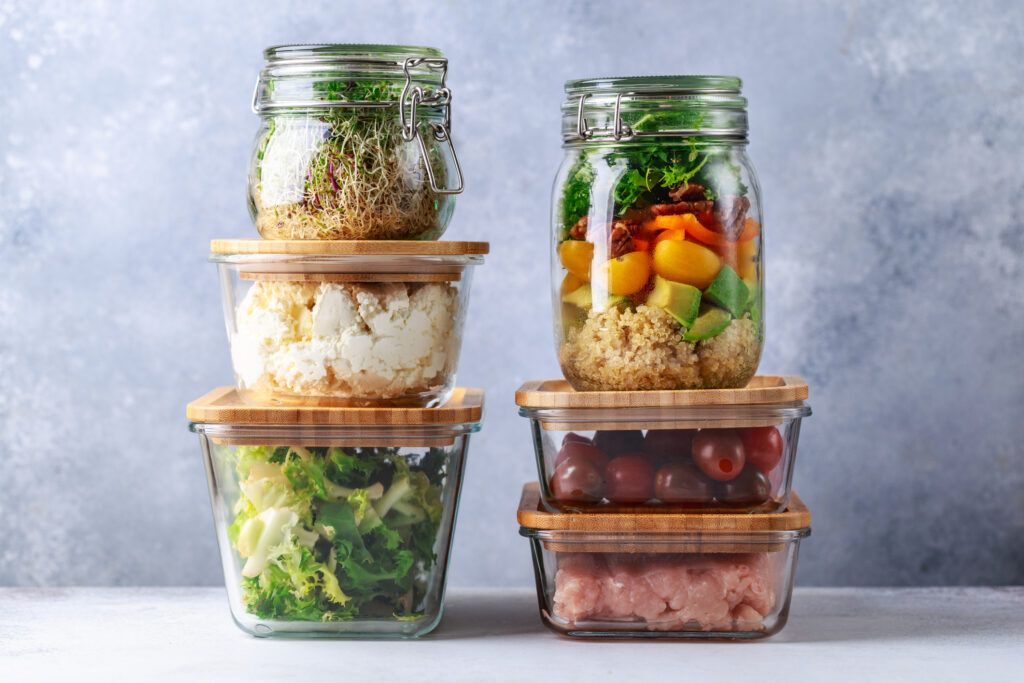We all know there’s no free lunch… but with a little meal prepping, there’s a much more affordable lunch for every day of the week! By preparing your lunches for the week ahead, you can reduce your spending on eating out or ordering takeout and eating out. Planning ahead also makes it easier to eat healthier foods. Here are some tips to get you started meal prepping for the week to save money on lunch, as well as some meal prep lunch ideas.
1. Plan your meals
The first step in successful meal prep is making a plan for the week. Think about what you like to eat, and what’s easy to prepare in advance. You’ll want to strike a balance between variety and simplicity. Aim for meals that are nutritious, satisfying, and can be prepared in batches.If you need inspiration, here are some meal prep lunch ideas.
2. Make a shopping list
Once you’ve planned your meals, create a shopping list with all of the ingredients you need. Stick to the list when you go grocery shopping to avoid buying unnecessary items. That way you avoid wasting food and money. To make sure your money goes as far as possible at the store, check out our tips for grocery shopping on a budget.
3. Invest in quality containers
Another key step in your meal prepping journey is buying a set of quality containers—look for some that are a good size for storing your prepped meals. You’ll want containers that are microwave-safe, leak-proof, and stackable for easy storage. Having the right containers makes meal prep more efficient and keeps your food fresh.
4. Choose versatile ingredients
When selecting ingredients for your meals, opt for things that can be used in multiple recipes. For example, chicken breast, brown rice, and mixed vegetables can be used in several different lunches throughout the week. Minimizing the number of different ingredients you have to buy really helps cut costs.
5. Prepare in batches
Dedicate a specific day or time each week to make your meals in batches. Prepare large quantities of protein, grains, and vegetables at once. You can bake several chicken breasts, cook a big pot of rice, and roast a bunch of vegetables. This makes it easy to assemble different meals quickly.
6. Mix and match ingredients
Create variety in your lunches by mixing and matching the ingredients you’ve prepared. For example, you can combine cooked chicken with different sauces or seasonings to create various flavors. Use your prepped vegetables in salads, wraps, or grain bowls.
7. Portion control
When you’re packing your prepped meals, pay close attention to portion sizes. Overeating can lead to food waste and negate your cost-saving efforts. Use measuring cups or a food scale to measure portions.
8. Freeze for longevity
If you’re concerned about the freshness of your meals toward the end of the week, consider freezing some of them. Certain dishes, like soups and stews, freeze well and can be easily reheated. Label them with the date to keep track of freshness.
9. Store properly
Proper storage is vital for the safety and freshness of your meals. Refrigerate perishable items right away, and make sure your fridge is at the right temperature (below 40°F). Store raw ingredients separately from cooked ones to prevent cross-contamination.
10. Prep snacks too
Don’t forget to include snacks in your meal prep routine. Preparing healthy snacks like cut up fruit, yogurt cups, or nuts can help you avoid vending machine or convenience store food, which is usually not healthy and can kill your budget quickly.
11. Plan for leftovers
Cook extra portions of your dinner meals so you have leftovers for lunch the next day. This not only saves money but also helps you spend less time on meal prep.
12. Track your savings
Keep track of how much money you save by meal prepping. Compare your weekly meal prep costs to what you used to spend on eating out or ordering takeout. Seeing the awesome savings can help keep you motivated to continue meal prepping.
13. Be flexible
While it’s great to have a meal plan, be flexible enough to adapt to changes in your schedule or preferences. If you’re not in the mood for a specific prepped meal, swap it out for another option. The goal is to make your meals enjoyable and sustainable.
14. Start small
If you’re new to meal prepping, start small and gradually increase the number of meals you prepare in advance. It’s a good way to develop your skills and routines without feeling overwhelmed.
15. Stay consistent
Routine is key to successful meal prep. Make it a weekly habit, and over time, it will become second nature. Set aside a specific day and time for meal prep in your schedule to keep it a priority.
The bottom line: meal prepping
Meal prepping is a great way to save money on lunch while eating healthy and satisfying food. With careful planning, efficient cooking, and the right storage containers, you can enjoy homemade lunches that are both budget-friendly and enjoyable. Plus, the time and effort you invest in meal prep will pay off in terms of convenience and healthier eating habits. So start meal prepping today and start saving money on lunch.









